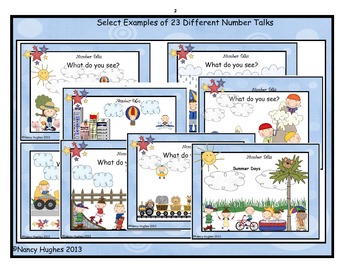

Instead of simply telling my son how many apples I think we need and putting them in a bag and moving on, I take the time to stop and ask open-ended questions and listen carefully to his responses. Ask open-ended questions to sustain math talk as long as possible. The goal of math talk is to keep the child talking. For example, I’ve asked my son “How many apples do you think we need to buy?” If he tells me we need six, I ask “Why do we need six?” His answers often involve explanations about the number of days in a week, how many people we have in our house, who likes apples and who does not, whether we usually cut the apples up into smaller pieces or eat them whole, and how many apples each of us usually eat in one sitting.Ĥ. The problem solving involved in an everyday discussion about how much of a specific food our family needs involves a lot of math concepts and content. Look for opportunities to problem solve. One of my favorite places to ask my 4-year-old son questions about math is the grocery store.

On a drive or a walk you might say, “I see two geese on this side of the lake and three geese on the other side. Once children are able to add, look for opportunities to allow them to do this. Look for opportunities to count or add. Count the number of green tiles on the floor of the grocery store or the number of cracks you walk over on the sidewalk.
#Number talks kindergarten how to
A mother balancing a checkbook might ask, “Dillon, can you help me add up these numbers?” When shopping, parents can discuss how much things cost and how to decide which things are the best bargain and what things can be bought with a certain budget.Ģ. Kindergarten and older: Ask older children to help with the math that we encounter in everyday situations. Sometimes just being quiet and listening is the best thing we can do. Try not to correct them or interrupt them. As he started to count his fingers, he stopped and said, almost to himself, “Whaaaaaat? It’s six!” Letting children talk through their solutions and math thinking is very important. I said, “Really, show me.” Then he put up three fingers on each hand and began to count.
#Number talks kindergarten plus
Another time my son told me three plus three was five. I asked him how he knew, and he showed me using his fingers.Įven wrong answers provide opportunities. One morning my 4-year-old told me that eight plus eight was sixteen. Soon they will begin asking you questions. Preschoolers need time to work out the problem on their own. The key here is to engage in discussion, not rapid fire question and answer sessions. Parents can discuss simple addition problems-such as “I wonder what four plus four is”-and let the child think about it and work it out. Preschoolers: Preschool children are capable of some amazing mathematical thinking. Toddlers: An aunt walking down the street with her toddler nephew says “Let’s count the light poles! I see one light pole! OH! I see another! That is two! Do you see another one?” That’s math talk.Ī mother cooking with her child says, “How many more times do I need to stir the brownies?” and then “OK, I stirred them five times. Infants: When a dad hides his face behind his hands and says, “One, two, three, peek-a-boo!”his baby learns to anticipate seeing his dad’s face as a result of the counting (even as an infant).

Here are a few examples for each age and stage. Math talk is simply talking to your child about the math that they experience. Here are five ways to use math talk with your child.ġ. The more parents talk with their child about math at home, the more a child’s mind is stimulated to think about math. This same principle holds true for mathematics. Children who come from homes where there are a lot of books and where family members talk about what they have read, for example, have been shown to have better literacy outcomes in kindergarten and successive grades 1. Talk is a fundamental way children learn, even before they understand what is being said. Dad counters, “Wow, that’s a lot of donuts! How many do we need so Mommy, Daddy, your sister, and you can have one?” Clark proceeds to think, count, and problem solve as the father continues to prompt him to use math to decide how many donuts to purchase. Clark asks, “Can we get donuts?” “How many should we get?” his father responds. A father and 3-year-old son, Clark, walk through the supermarket.


 0 kommentar(er)
0 kommentar(er)
